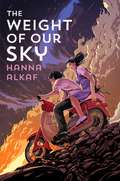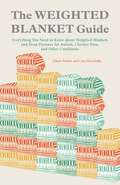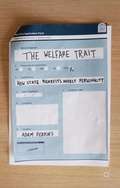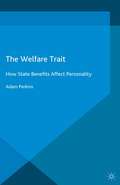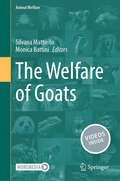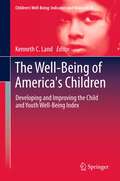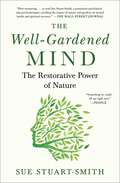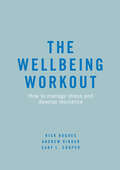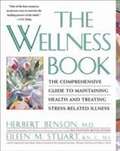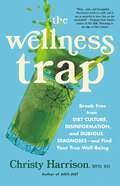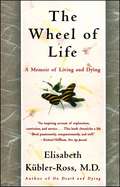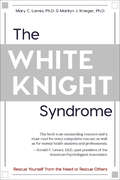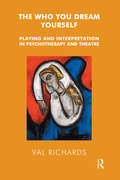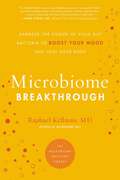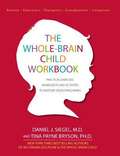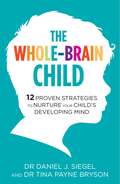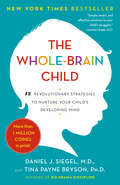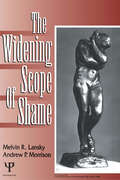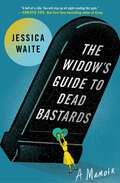- Table View
- List View
The Weight of Our Sky
by Hanna AlkafA music loving teen with OCD does everything she can to find her way back to her mother during the historic race riots in 1969 Kuala Lumpur, Malaysia, in this heart-pounding literary debut.Melati Ahmad looks like your typical movie-going, Beatles-obsessed sixteen-year-old. Unlike most other sixteen-year-olds though, Mel also believes that she harbors a djinn inside her, one who threatens her with horrific images of her mother&’s death unless she adheres to an elaborate ritual of counting and tapping to keep him satisfied. A trip to the movies after school turns into a nightmare when the city erupts into violent race riots between the Chinese and the Malay. When gangsters come into the theater and hold movie-goers hostage, Mel, a Malay, is saved by a Chinese woman, but has to leave her best friend behind to die. On their journey through town, Mel sees for herself the devastation caused by the riots. In her village, a neighbor tells her that her mother, a nurse, was called in to help with the many bodies piling up at the hospital. Mel must survive on her own, with the help of a few kind strangers, until she finds her mother. But the djinn in her mind threatens her ability to cope.
The Weighted Blanket Guide: Everything You Need to Know about Weighted Blankets and Deep Pressure for Autism, Chronic Pain, and Other Conditions
by Eileen Parker Cara KoscinskiProviding everything you need to know about the use of weighted blankets to help with sensory integration, improve sleep, ease chronic pain and more, this book includes: · What a weighted blanket is and how it works · An exploration of deep pressure and how weight on the body affects the mind · Guidelines for using weighted blankets at home and in professional environments · Studies into the effectiveness of weighted blankets · Advice on how to select an appropriate weighted blanket or sew your own. Based on the latest research, this book dispels the online myths surrounding weighted blankets. It delivers clear information for occupational therapists and anyone considering using a weighted blanket to help with sensory processing disorder, autism, sleep disorders, fibromyalgia, post-traumatic stress disorder, and more.
The Welfare Trait: How State Benefits Affect Personality
by Adam PerkinsThe welfare state has a problem: each generation living under its protection has lower work motivation than the previous one. In order to fix this problem we need to understand its causes, lest the welfare state ends up undermining its own economic and social foundations. In The Welfare Trait, award-winning personality researcher Dr Adam Perkins argues that welfare-induced personality mis-development is a significant part of the problem. In support of his theory, Dr Perkins presents data showing that the welfare state can boost the number of children born into disadvantaged households, and that childhood disadvantage promotes the development of an employment-resistant personality profile, characterised by aggressive, antisocial and rule-breaking tendencies. The book concludes by recommending that policy should be altered so that the welfare state no longer increases the number of children born into disadvantaged households. It suggests that, without this change, the welfare state will erode the nation's work ethic by increasing the proportion of individuals in the population who possess an employment-resistant personality profile, due to exposure to the environmental influence of disadvantage in childhood.
The Welfare Trait: How State Benefits Affect Personality
by Adam PerkinsThe welfare state has a problem: each generation living under its protection has lower work motivation than the previous one. In order to fix this problem we need to understand its causes, lest the welfare state ends up undermining its own economic and social foundations. In The Welfare Trait, award-winning personality researcher Dr Adam Perkins argues that welfare-induced personality mis-development is a significant part of the problem. In support of his theory, Dr Perkins presents data showing that the welfare state can boost the number of children born into disadvantaged households, and that childhood disadvantage promotes the development of an employment-resistant personality profile, characterised by aggressive, antisocial and rule-breaking tendencies. The book concludes by recommending that policy should be altered so that the welfare state no longer increases the number of children born into disadvantaged households. It suggests that, without this change, the welfare state will erode the nation's work ethic by increasing the proportion of individuals in the population who possess an employment-resistant personality profile, due to exposure to the environmental influence of disadvantage in childhood.
The Welfare of Animals in Animal-Assisted Interventions: Foundations and Best Practice Methods
by Aubrey H. Fine Jose M. PeraltaThis is the first book focusing on the animal’s perspective and best practices to ensure the welfare of both therapy animals and their human counterparts in animal-assisted interventions. Written by leading scientists, it summarizes the scientific evidence available concerning the impacts on animals in these settings, including companion species, horses, marine mammals and other animals used in therapy.There has been a dramatic increase in the range of animal-assisted interventions used in medical and allied health environments in recent years, and the field is now entering an era with a greater interest in defining the underlying mechanisms of the human-animal bond as well as the therapeutic benefits of these interactions. Animal-assisted interventions, as with other uses of animals by humans, impose a unique set of stresses on the animals, which the community has only recently begun to acknowledge. For the field to continue to flourish, more evidence is needed to shed light on the implications for the animals and what guidelines need to be put into practice to ensure welfare.With the ultimate goal of improving the impact that we have on the animals under our care, the book provides a roadmap for researchers and clinicians as they attempt to safely and humanely incorporate various species of animals into therapeutic settings. The authors also offer instructions and suggestions for areas that need to be studied more robustly over the next decade to continue to ensure the safe and proper use of animals in therapy sessions.This is an informative, thought-provoking and instructive resource for practitioners and researchers in the field of medicine and clinical psychology using animal-assisted interventions, as well as for veterinarians and welfare scientists.
The Welfare of Goats (Animal Welfare #25)
by Silvana Mattiello Monica BattiniThis book focuses exclusively on the welfare of goats, which have peculiar behavioral characteristics and needs, and distinct individual personalities. Despite the many differences between goats and sheep, welfare and health issues of small ruminants have often been addressed together. Goats are extremely adaptable, now widespread and farmed all over the world. Usually bred for economic purposes (milk, meat and/or fibre), goats are also occasionally kept as pet animals, in educational farms, in zoos or for animal-assisted therapy. This wide range of conditions may elicit different challenges for their welfare. Readers of this volume are introduced to the goat species, starting from its origin and domestication process, and presentation of its natural behaviour and characteristics, including recent data on goats’ ability to communicate, cognition capabilities and personality. Knowledge of these features is indispensable to allow a welfare-friendly approach to goat management. The authors then address all relevant aspects of goat welfare, covering issues related to housing, feeding, painful procedures and end-of-life management, with special emphasis on welfare challenges in adverse environments. An additional chapter is dedicated to the main health problems that can jeopardize goats’ welfare. Finally, this volume highlights the latest research to on-farm welfare assessment with indicators and protocols for evaluation. This work will appeal to scholars of animal welfare science and biology, stakeholders in the livestock industry, as well as experts in goat-assisted interventions and pet owners. Video and audio files enrich the reading experience and can also be played from the print book using the free Springer Nature More Media app.
The Well-Being of America's Children
by Kenneth C. LandIn 1998, the Foundation for Child Development (FCD) provided Kenneth Land a grant to explore the feasibility of producing the first national composite index of the status of American children that would chart changes in their well-being over time. Important questions needed to be answered: was it possible to trace trends in child and youth well-being over several decades? Could such an index provide a way of determining whether the United States was making progress in improving its children's lives? The Index of Child and Youth Well-Being (CWI) was born from these questions. Viewing the CWI trends from 1975 to present, there is evidence that the well-being of American children lags behind other Western nations. As conditions change, it is clear that the index is an evolving and rich enterprise. This volume attests to that evolution, and what the CWI promises for understanding the progress - or lack of progress - in enhancing the life prospects of all American children.
The Well-Being of the Elderly in Asia: A Four-Country Comparative Study
by Albert I. HermalinThe past two decades have witnessed rapid social, economic, and demographic change in East and South-East Asia. The older populations in these regions have been increasing faster than in the West, and the proportions of people over sixty will more than double over the next thirty years. Increased urbanization and educational levels and a strong shift to professional, technical, manufacturing, and service occupations are changing the social and economic landscape, leading to concern for the well-being of the elderly, who traditionally have relied on the family for support. Governments are attempting to preserve these traditions while taking into account widespread family change and new expectations for pension, health insurance, and other public programs. The contributors to this volume use survey and other data collected over ten years to examine the well-being of the current older population in four Asian countries: The Philippines, Singapore, Taiwan, and Thailand. Each major analytic chapter looks at a key dimension of well-being--economic, physical and mental health, work and leisure--and how these are affected by the familial and social support arrangements, as well as age, gender, education, and urban-rural residence. Where possible, changes over time are traced. Explicit attention is given to the policies and programs in place and under development in each country and to the cultural accommodations underway. The contributors also look ahead to the implications of the large numbers of elderly with very different characteristics who will predominate in the coming years and to the policy implications of this coming transformation. The book will be important for scholars and policymakers whose work involves population in Asia, including demographers, sociologists, and economists.
The Well-Gardened Mind: The Restorative Power of Nature
by Sue Stuart-SmithA distinguished psychiatrist and avid gardener offers an inspiring and consoling work about the healing effects of gardening and its ability to decrease stress and foster mental well-being in our everyday lives.The garden is often seen as a refuge, a place to forget worldly cares, removed from the &“real&” life that lies outside. But when we get our hands in the earth we connect with the cycle of life in nature through which destruction and decay are followed by regrowth and renewal. Gardening is one of the quintessential nurturing activities and yet we understand so little about it. The Well-Gardened Mind provides a new perspective on the power of gardening to change people&’s lives. Here, Sue Stuart-Smith investigates the many ways in which mind and garden can interact and explores how the process of tending a plot can be a way of sustaining an innermost self. Stuart-Smith&’s own love of gardening developed as she studied to become a psychoanalytic psychotherapist. From her grandfather&’s return from World War I to Freud&’s obsession with flowers to case histories with her own patients to progressive gardening programs in such places as Rikers Island prison in New York City, Stuart-Smith weaves thoughtful yet powerful examples to argue that gardening is much more important to our cognition than we think. Recent research is showing how green nature has direct antidepressant effects on humans. Essential and pragmatic, The Well-Gardened Mind is a book for gardeners and the perfect read for people seeking healthier mental lives.
The Wellbeing Workout: How to manage stress and develop resilience
by Cary L. Cooper Rick Hughes Andrew KinderIf you want to get physically fit you start working out. But if you want results, you can’t just do just any workout – you need one tailored to your own body’s needs and personal situation. It’s the same with wellbeing. What constitutes ‘stress’ to one person may be motivating, inspiring and focusing for another. Our capacity for resilience varies depending on individual circumstances and from situation to situation. What is consistent and universal is that we all struggle with stress and resilience, and we all need to be open to figuring out how best to effectively manage stress to create greater personal resilience that will itself help us to cope better. This book offers you an encyclopaedia of self-help options for you to adapt according to how you tick and to the circumstances you find yourself in at any given moment. It addresses 60 different issues, and for each one provides a short ‘Spotlight’ to understand the issue, ‘Top Tips’ for dealing with it, and an ‘Action Plan’ to put those tips into practice. Wellbeing is about managing the ebbs and flows of what life throws at us. It’s a mindset, a personal commitment and an ongoing endeavour. But if we adopt a focused and sustained engagement with this journey, then we’ll learn to embrace and reap the benefits of ‘being well’.
The Wellness Book: The Comprehensive Guide to Maintaining Health and Treating Stress-Related Illness
by Herbert Benson Eileen M. Stuart Michael P. GoldbergThe Wellness Book shows readers how to create and control their own well being. Use of the book, in combination with modern medical treatments, will aid in prevention and treatment of a number of illnesses and, according to USA TODAY, “legitimizes the mind/body connection in traditional medicine.” <P><P>Millions of readers are familiar with the work of Dr. Herbert Benson and the Mind/Body Medical Institute from his mega-bestselling book The Relaxation Response . With more than 5 million copies in print, it is a classic in the field of mind/body medicine. In The Wellness Book, Dr. Benson has created the definitive resource that shows readers how to maintain health and treat stress-related illnesses, including high blood pressure, cardiovascular disease, chronic pain, Parkinson’s Disease, infertility, insomnia, anxiety, symptoms of HIV and cancer, menopause, and more.
The Wellness Trap: Break Free from Diet Culture, Disinformation, and Dubious Diagnoses, and Find Your True Well-Being
by Christy HarrisonAS SEEN ON CBS MORNINGS, THE NEW YORK TIMES, THE CUT, AND MORESELF MAGAZINE&’S #1 WELLNESS BOOK OF 2023A NEXT BIG IDEA CLUB MUST-READ BOOK FOR APRIL 2023 A searing critique of modern wellness culture and how it stands in the way of true well-being that "will change the way you think about your health—in all the best ways.&” (Casey Gueren) &“It's not a diet, it's a lifestyle.&” You've probably heard this phrase from any number of people in the wellness space. But as Christy Harrison reveals in her latest book, wellness culture promotes a standard of health that is often both unattainable and deeply harmful. Many people with chronic illness understandably feel dismissed or abandoned by the healthcare system and find solace in alternative medicine, as Harrison once did. Yet the wellness industry promotes practices that often cause even more damage than the conventional approaches they&’re meant to replace. From the lack of pre-market safety testing on herbal and dietary supplements, to the unfounded claims made by many wellness influencers and functional-medicine providers, to the social-media algorithms driving users down rabbit holes of wellness mis- and disinformation, it can often feel like no one is looking out for us in the face of the $4.4 trillion global wellness industry.The Wellness Trap delves into the persistent, systemic problems with that industry, offering insight into its troubling pattern of cultural appropriation and its destructive views on mental health, and shedding light on how a growing distrust of conventional medicine has led ordinary people to turn their backs on science. Weaving together history, memoir, reporting, and practical advice, Harrison illuminates the harms of wellness culture while re-imagining our society&’s relationship with well-being.
The Wheel of Life
by Elisabeth Kübler-RossOn Life and Living Elisabeth Kübler-Ross, M.D., is the woman who has transformed the way the world thinks about death and dying. Beginning with the groundbreaking publication of the classic psychological study On Death and Dying and continuing through her many books and her years working with terminally ill children, AIDS patients, and the elderly, Kübler-Ross has brought comfort and understanding to millions coping with their own deaths or the deaths of loved ones. Now, at age seventy-one facing her own death, this world-renowned healer tells the story of her extraordinary life. Having taught the world how to die well, she now offers a lesson on how to live well. Her story is an adventure of the heart -- powerful, controversial, inspirational -- a fitting legacy of a powerful life.
The White Knight Syndrome: Rescuing Yourself from Your Need to Rescue Others
by Mary C. Lamia Marilyn J. KriegerBreak the pattern of losing yourself in other people&’s problems with this &“outstanding resource and must-read for every compulsive rescuer&” (Ronald F. Levant, Ed. D.).Are you attracted to needy, damaged, or helpless people? Are you overly involved in your partner's problems? Are you hungry for constant reassurance in relationships? Do you try to &“save&” people from themselves?In legends and fairytales, the white knight rescues the damsel in distress, falls in love, and saves the day. Real-life white knights are men and women who enter into romantic relationships with damaged and vulnerable partners, hoping that love will transform their partner&’s behavior or life. It&’s a relationship pattern that seldom leads to a storybook ending.Hoping to receive validation and love from their partners, white knights only cheat themselves out of emotionally healthy relationships. If this sounds like you, it's time to come to your own rescue. With engaging insight and informative case studies, The White Knight Syndrome is a guide to understanding and resolving the white knight syndrome in yourself.
The Who You Dream Yourself: Playing and Interpretation in Psychotherapy and Theatre
by Val RichardsThe motif of time and space runs as a continual thread through this book, which examines the relationship between psychotherapy and the theatre as underpinned by Winnicott's writings. The author supplements her theories with Jung's ideas on self, the writings of Lacan and the prose, drama and poetry of Yeats - an unusual blend between diverse and often opposing schools of thought.
The Whole Brain Business Book: Unlocking the Power of Whole Brain Thinking in Organizations and Individuals
by Ned Herrmann Ann Herrmann-Nehdi<p>If you think your business can’t get any better, think again. Thanks to the power of Whole Brain® Thinking, you can apply what we know about thinking and the brain to transform your organization at every level. Whether you’re struggling to keep up with a changing market, stuck with a tired business model, or challenged by difficult colleagues, the proven methods in this updated guide will help you. <p>This revised and expanded edition features the latest brain research, updated real-world examples, and more actionable content than ever before. In addition to new stories, data and “mind-hacks”, you’ll find Herrmann’s timeless tips for getting unstuck, identifying the four thinking preferences, and applying research-based techniques that have been proven to work in any business environment around the world. By building and strengthening your thinking agility, you’ll be able to work more effectively with others―and leverage the best thinking around―so you can avoid costly delays, missed opportunities, and other business risks. Using the book’s point-by-point action steps, insightful case studies, and emerging thought trends, you can really put your mind to work―and get brilliant results. <p>The Whole Brain Business Book will help optimize your management approach, align your organization and strategy, and fully engage your own brain as well as the brains of others to work smarter, faster, and better than you ever thought possible.</p>
The Whole Brain: The Microbiome Solution to Heal Depression, Anxiety, and Mental Fog without Prescription Drugs (Microbiome Medicine Library)
by Raphael KellmanFunctional medicine pioneer and author of The Microbiome Diet offers his groundbreaking, medication-free, scientifically based approach to healing depression, anxiety, and brain fog by focusing on your "whole brain"--the brain, the gut, the microbiome, and the thyroid.If you are one of the millions of people who feel that your brain just "isn't working right"--that you have brain fog, memory loss, depression, anxiety, or that your ability to maintain a balanced, happy mood has been lost long ago--take heart. The problem is not "in your head," it is in your microbiome (the trillions of health-promoting bacteria) and your gut--and there are proven natural solutions that can help you not only reduce symptoms but also improve your vitality, cognitive function, and zest for life.A pioneer in holistic and functional medicine, Dr. Raphael Kellman has spent the last two decades treating countless patients with complaints like these. Through years of research, he developed a groundbreaking approach to brain health that goes far beyond conventional understanding of the brain. The Whole Brain introduces you to the complete system that affects your mental health: not just your brain, but your gut, microbiome, and thyroid as well. You'll learn about the latest cutting-edge science, and will discover The Whole Brain Protocol. This powerful four-week plan advises you exactly what to eat and which supplements and probiotics to take, so that your brain functions at its deepest level, every day, all the time. Along with delicious, health-supporting recipes, meal plans, and other tips and strategies, The Whole Brain will help you make your own brain work better so that you can feel calm, energized, clear, sharp, and optimistic--without prescription medications.
The Whole-Brain Child Workbook: Practical Exercises, Worksheets and Activities To Nurture Developing Minds
by Daniel J. Siegel Tina Payne BrysonThe Whole-Brain Child Workbook has a unique, interactive approach that allows readers not only to think more deeply about how the ideas fit their own parenting approach, but also develop specific and practical ways to implement the concepts--and bring them to life for themselves and for their children. Dozens of clear, practical and age specific exercises and activities. Applications for clinicians, parents, educators, grandparents and care-givers.
The Whole-Brain Child: 12 Proven Strategies to Nurture Your Child's Developing Mind
by Dr. Tina Payne Bryson Dr. Daniel SiegelIn this pioneering, practical book for parents, neuroscientist Daniel J. Siegel and parenting expert Tina Payne Bryson explain the new science of how a child's brain is wired and how it matures. Different parts of a child's brain develop at different speeds and understanding these differences can help you turn any outburst, argument, or fear into a chance to integrate your child's brain and raise calmer, happier children. Featuring clear explanations, age-appropriate strategies and illustrations that will help you explain these concepts to your child, The Whole-Brain Child will help your children to lead balanced, meaningful, and connected lives using twelve key strategies, including:Name It to Tame It: Corral raging right-brain behavior through left-brain storytelling, appealing to the left brain's affinity for words and reasoning to calm emotional storms and bodily tension.Engage, Don't Enrage: Keep your child thinking and listening, instead of purely reacting.Move It or Lose It: Use physical activities to shift your child's emotional state.Let the Clouds of Emotion Roll By: Guide your children when they are stuck on a negative emotion, and help them understand that feelings come and go.SIFT: Help children pay attention to the Sensations, Images, Feelings, and Thoughts within them so that they can make better decisions and be more flexible.Connect Through Conflict: Use discord to encourage empathy and greater social success.
The Whole-Brain Child: 12 Revolutionary Strategies to Nurture Your Child's Developing Mind
by Daniel J. Siegel Tina Payne BrysonYour toddler throws a tantrum in the middle of a store. Your preschooler refuses to get dressed. Your fifth-grader sulks on the bench instead of playing on the field. Do children conspire to make their parents' lives endlessly challenging? No--it's just their developing brain calling the shots!In this pioneering, practical book, Daniel J. Siegel, neuropsychiatrist and author of the bestselling Mindsight, and parenting expert Tina Payne Bryson demystify the meltdowns and aggravation, explaining the new science of how a child's brain is wired and how it matures. The "upstairs brain," which makes decisions and balances emotions, is under construction until the mid-twenties. And especially in young children, the right brain and its emotions tend to rule over the logic of the left brain. No wonder kids can seem--and feel--so out of control. By applying these discoveries to everyday parenting, you can turn any outburst, argument, or fear into a chance to integrate your child's brain and foster vital growth. Raise calmer, happier children using twelve key strategies, including * Name It to Tame It: Corral raging right-brain behavior through left-brain storytelling, appealing to the left brain's affinity for words and reasoning to calm emotional storms and bodily tension.* Engage, Don't Enrage: Keep your child thinking and listening, instead of purely reacting.* Move It or Lose It: Use physical activities to shift your child's emotional state.* Let the Clouds of Emotion Roll By: Guide your children when they are stuck on a negative emotion, and help them understand that feelings come and go.* SIFT: Help children pay attention to the Sensations, Images, Feelings, and Thoughts within them so that they can make better decisions and be more flexible.* Connect Through Conflict: Use discord to encourage empathy and greater social success. Complete with clear explanations, age-appropriate strategies for dealing with day-to-day struggles, and illustrations that will help you explain these concepts to your child, The Whole-Brain Child shows you how to cultivate healthy emotional and intellectual development so that your children can lead balanced, meaningful, and connected lives.From the Hardcover edition.
The Wicker King: A Novella Of The Wicker King
by K. AncrumThe Wicker King is a psychological young adult thriller that follows two friends struggling as one spirals into madness. Jack once saved August's life…now can August save him?August is a misfit with a pyro streak and Jack is a golden boy on the varsity rugby team—but their intense friendship goes way back. Jack begins to see increasingly vivid hallucinations that take the form of an elaborate fantasy kingdom creeping into the edges of the real world. With their parents’ unreliable behavior, August decides to help Jack the way he always has—on his own. He accepts the visions as reality, even when Jack leads them on a quest to fulfill a dark prophecy. August and Jack alienate everyone around them as they struggle with their sanity, free falling into the surreal fantasy world that feels made for them. In the end, each one must choose his own truth.Written in vivid micro-fiction with a stream-of-consciousness feel and multimedia elements, K. Ancrum's The Wicker King touches on themes of mental health and explores a codependent relationship fraught with tension, madness and love.
The Widening Scope of Shame
by Andrew P. Morrison Melvin R. LanskyThe Widening Scope of Shame is the first collection of papers on shame to appear in a decade and contains contributions from most of the major authors currently writing on this topic. It is not a sourcebook, but a comprehensive introduction to clinical and theoretical perspectives on shame that is intended to be read cover to cover. The panoramic scope of this multidisciplinary volume is evidenced by a variety of clinically and developmentally grounded chapters; by chapters explicating the theories of Silvan Tomkins and Helen Block Lewis; and by chapters examining shame from the viewpoints of philosophy, social theory, and the study of family systems. A final section of brief chapters illuminates shame in relation to specific clinical problems and experiential contexts, including envy, attention deficit disorder, infertility, masochism, the medical setting, and religious experience. This collection will be of special interest to psychoanalytically oriented readers. It begins with a chapter charting the evolution of Freud's thinking on shame, followed by chapters providing contemporary perspectives on the role of shame in development, and the status of shame within the theory of narcissism. Of further psychoanalytic interest are two reprinted classics by Sidney Levin on shame and marital dysfunction. In both depth of clinical coverage and breadth of perspectives, The Widening Scope of Shame is unique in the shame literature. Readable, well organized, and completely up to date, it becomes essential reading for all students of this intriguing and unsettling emotion and of human development more generally.
The Widow's Guide to Dead Bastards
by Jessica WaiteAfter the sudden death of her husband, a woman unearths surprising revelations about the man she was married to for seventeen years. A compulsively readable, darkly funny, posthumous love story about loss, grief, and unresolved relationships.Jessica Waite&’s successful, charismatic husband, Sean, is on his way home from a business trip when he collapses in a Houston airport. Having begun the day as a wife, by noon she is a widow and the sole living parent to their nine-year-old son. The day after Sean&’s funeral, Jessica receives a box of his personal effects and discovers the secrets her husband had been hiding—including drug abuse, compulsive spending, infidelity, and a massive porn cache. Jessica hides these revelations from her grief-stricken son while also trying to erase Sean from her own life. She rids their bedroom of his belongings. She grants herself a &“divorce.&” She conceives a revenge plan to unleash on Christmas Eve. But when things start happening that Jessica can&’t explain—like signs from beyond and strange coincidences pointing her in the direction of forgiveness— she is forced to choose: Endure the bitter aftermath of her old life? Or reconsider her views? Written with dark humor in the vein of Liz Feldman&’s series Dead to Me and Jennette McCurdy&’s I&’m Glad My Mom Died, The Widow&’s Guide to Dead Bastards is a searing and hilarious memoir that asks the question: Does death signify the end of a relationship, or can there be an afterlife epilogue?
The Widow's Guide to Dead Bastards
by Jessica Waite&“You will stay up all night reading this gem&” (Christie Tate, New York Times bestselling author) about a widow whose life is turned upside down when she uncovers the truth about her late husband. A lyrical, witty, and deeply moving memoir of betrayal and forgiveness.While mourning her husband&’s sudden death, Jessica Waite discovered shocking secrets that undermined everything she thought she knew about the man she&’d loved and trusted. From secret affairs to drug use and a pornography addiction, Waite was overwhelmed reconciling this devastating information with her new reality as a widowed single mom. Then, to further complicate matters, strange, inexplicable coincidences forced her to consider whether her husband was reaching back from beyond the grave. With unflinching honesty, Waite details her tumultuous love story and the pain of adjusting to the new normal she built for herself and her son. &“A candid, raw chronicle of bereavement&” (Kirkus Reviews), The Widow&’s Guide to Dead Bastards is also a lyrical exploration of mental health, single parenthood, and betrayal that demonstrates that the most moving love stories aren&’t perfect—they&’re flawed and poignantly real.
